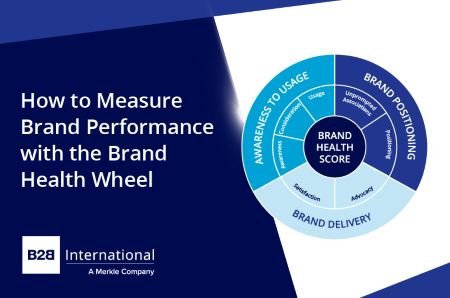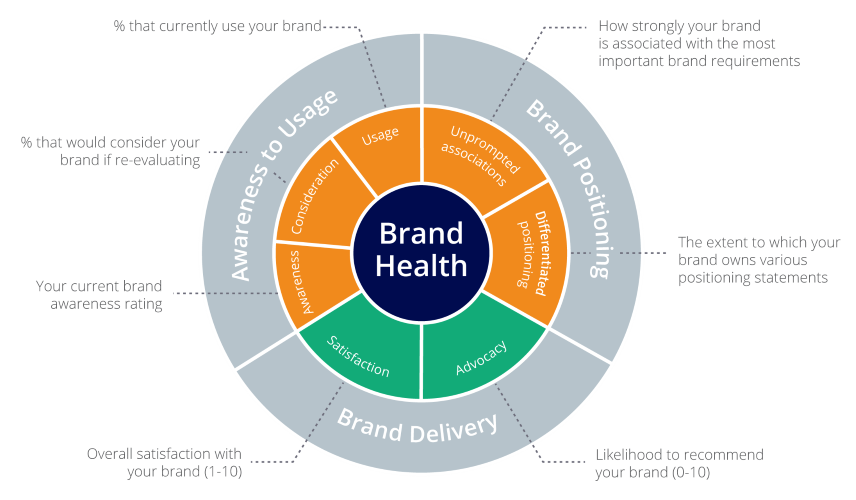
When measuring brand performance or assessing brand health, it’s very easy to quickly be surrounded by a range of questions, metrics and performance indicators which can make it difficult to confidently answer the question “how is my brand performing?”.
The Brand Health Wheel combines these many questions and metrics to provide a simple, easy-to-read view of brand performance that can be compared across different brands, by business segment, markets or geographies.

Drawing from the AIDA model (the four stages that a consumer goes through before making a purchasing decision – Attention, Interest, Desire, and Action), the Brand Health Wheel clearly distinguishes between core elements of brand performance whilst remaining flexible enough to adapt its component measures based on the metrics being tracked. As a result, it can be modified to include historical metrics or reflect organization-specific values.
The three elements of the Brand Health Wheel are;
-
Awareness, consideration & usage:
For a brand to have value, the target audience must at the very least be aware of the brand and ideally consider it or use it. Whilst consideration and usage are relatively straightforward to measure, there are different options around awareness – namely, is our focus on spontaneous recall of the brand or on prompted/total awareness. In terms of brand performance and likely usage and perceptions, spontaneous recall (either as the first or one of the first brands recalled) is the strongest measure and the preferable metric to use. We know that in the majority of cases, individuals are more likely to purchase from brands they know and recall spontaneously.
-
Brand positioning:
Understanding what a brand stands for and how it perceived in the eyes of the target audience is vital in delivering strong performance and making it distinct and different from competitors. It is also of great importance to consider whether this position and the strongest brand associations resonate with market needs and desires and align with the brand’s ambition.
Ideally, we want to assess performance on those attributes or associations that are most relevant to the target audience e.g. drivers of choice, consideration or preference. Alternatively, if the brand has a desired positioning or specific associations it wishes to purvey then performance on these can be measured e.g. values, characteristics or traits. Beyond this, additional performance metrics may be more category or organization-specific and can add to measuring brand health e.g. thought-leadership, credibility or a measure of perceived distinctiveness.
-
Brand delivery:
The final element to consider is an indication of the extent to which the brand is delivering against its promise i.e. by assessing levels of overall satisfaction or recommendation. These broader metrics can also be important in giving an indication of future potential of the brand by assessing whether or not it will be recommended or talked positively about.
Having established which elements to measure within the Brand Health Wheel, the next consideration how to assess performance on the different elements.
Often, absolute performance is used to assess brand strength i.e. assigning a score or measure for each element (often scored out of 100) and then grading performance in terms of poor, average and strong performance e.g. 30%, 50%, 70% or more. However, beyond tracking year-on-year changes or comparing between segments or markets, an absolute score such as this is of limited value due to a lack of competitive context and the varied nature of b2b markets making industry benchmarks difficult to come by and not always relevant. For example, low awareness in a niche market may not be as big an issue as in a more commoditized space and therefore a score of 50% may not actually be that poor.
As such, we recommend assessing performance throughout the Brand Health Wheel in relative terms i.e. directly vs the competition. This ensures that performance is measured against the most relevant or appropriate competitors and can be considered either versus an average of the competitive set being measured or against the leading competitor – perhaps where a brand is or desires to be the leading brand.
Measuring performance in relative, rather than absolute terms, requires an additional level of analysis as scores have to be interpreted in the context of competitive performance i.e. is a gap of 3pts ‘good’, is a lead of 5pts realistic, where does the gap become statistically significant? This can often require looking at results in different ways and across business segments or markets to ensure that the competitive ‘gap’ being assessed and considered ‘good’ or not is always appropriate.
This is a vital element of measuring brand health and assessing performance against alternative or substitute brands i.e. how are we performing against the brands that our customers are most likely to consider or choose if they don’t choose us?
To discuss how our tailored insights programs can help solve your specific business challenges, get in touch and one of the team will be happy to help.



